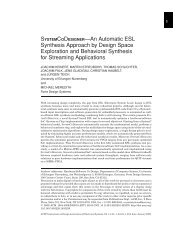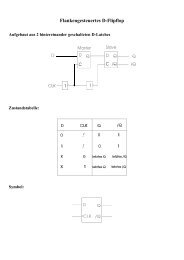Towards Robust Data Storage in Wireless Sensor Networks
Towards Robust Data Storage in Wireless Sensor Networks
Towards Robust Data Storage in Wireless Sensor Networks
Create successful ePaper yourself
Turn your PDF publications into a flip-book with our unique Google optimized e-Paper software.
Siegmund N, et al.: <strong>Towards</strong> <strong>Robust</strong> <strong>Data</strong> <strong>Storage</strong> <strong>in</strong> <strong>Wireless</strong> <strong>Sensor</strong> Network<br />
sufficient for sensor networks.<br />
Recovery: Features Recovery and Logg<strong>in</strong>g of FAME-DBMS<br />
have been designed and implemented for aggregation<br />
nodes. They enable data recovery of nodes that has temporarily<br />
failed. Recovery of data is required for aggregation<br />
nodes only because sensors usually store recently<br />
measured values non-persistently and cluster gateways<br />
only provide access to the network and do not store data.<br />
S-RAID: The features presented above are also applied<br />
<strong>in</strong> server DBMS and are implemented as specialized and<br />
modularized variants to fulfill all constra<strong>in</strong>ts of sensor<br />
networks. This approach, however, is not sufficient to<br />
provide robust data storage <strong>in</strong> sensor networks, s<strong>in</strong>ce<br />
nodes are not connected to ma<strong>in</strong>s power systems and<br />
may fail due to the use of batteries and faulty communication<br />
channels. In order to provide even access to data<br />
of a failed node of a sensor network, we propose to adopt<br />
the RAID approach (which is briefly described <strong>in</strong> Section<br />
3.3) for sensor networks and store data distributed<br />
over different nodes. Feature S-RAID shown <strong>in</strong> Figure 1<br />
represents functionality of the data management system<br />
used to store data <strong>in</strong> an underly<strong>in</strong>g abstract storage layer.<br />
S<strong>in</strong>ce this feature is optional, we can create variants of<br />
FAME-DBMS that use the underly<strong>in</strong>g RAID layer as well<br />
as variants that do not. This variability is needed because<br />
of different reliability requirements depend<strong>in</strong>g on the<br />
actual application scenario (i.e., some nodes do not need<br />
the RAID layer at all). In the last part of this section, we<br />
describe the planned RAID layer <strong>in</strong> more detail.<br />
3.2 <strong>Data</strong> Base Management System Variants for<br />
<strong>Sensor</strong> Nodes<br />
FAME-DBMS provides different variants of storage<br />
solutions for different node roles that can be found <strong>in</strong> a<br />
WSN. These different roles have different requirements<br />
on data management:<br />
• Endpo<strong>in</strong>t sensor: <strong>Sensor</strong> nodes require only rudimentary<br />
data management functionality. The ma<strong>in</strong> task of<br />
this node is to sense data and efficiently store simple<br />
key-value pairs. A data management solution for this<br />
role has to provide a m<strong>in</strong>imal footpr<strong>in</strong>t <strong>in</strong> order to be<br />
deployed on highly resource-constra<strong>in</strong>ed sensor devices.<br />
• Cluster gateway: The cluster gateway is the <strong>in</strong>terface for<br />
query<strong>in</strong>g data of a WSN. Therefore, a data management<br />
variant <strong>in</strong>cludes SQL support and a buffer manager<br />
optimized for sensor network queries. However, the<br />
variant provides only rudimentary storage functionality.<br />
• <strong>Data</strong> aggregator: Nodes that aggregate data have to<br />
provide advanced data management functionality<br />
to collect and store the data of a group of endpo<strong>in</strong>t<br />
sensor nodes. Additionally, <strong>in</strong>com<strong>in</strong>g queries are<br />
ma<strong>in</strong>ly executed on this node. Thus, the data management<br />
system has to provide <strong>in</strong>dexes for fast data access<br />
and buffer management for data storage. Because<br />
of lower hardware limitations compared to endpo<strong>in</strong>t<br />
sensors, a data management system may also <strong>in</strong>clude<br />
various other features, e.g., data encryption and <strong>in</strong>tegrity<br />
checks.<br />
Accord<strong>in</strong>g to the requirements on data management<br />
presented above, we can deploy different variants of<br />
FAME-DBMS. As shown <strong>in</strong> Table 1, the b<strong>in</strong>ary size of the<br />
different variants of FAME-DBMS ranges from 10 KB for<br />
endpo<strong>in</strong>t sensor nodes to 52 KB for data aggregation nodes.<br />
However, these are only the basic implementations, which<br />
might be customized accord<strong>in</strong>g to the specific application<br />
scenario. For example, feature Encryption might be added<br />
to all nodes to provide secure data storage and exchange.<br />
3.3 The RAID Layer<br />
Improved reliability of data storage <strong>in</strong> the doma<strong>in</strong> of<br />
server systems is usually achieved by us<strong>in</strong>g distributed<br />
DBMS. <strong>Data</strong> is stored redundantly <strong>in</strong> multiple physically<br />
dist<strong>in</strong>ct server systems. Each system conta<strong>in</strong>s a complete<br />
DBMS, which is the ma<strong>in</strong> reason why this solution cannot<br />
be applied to WSNs. To achieve distributed data storage<br />
on resource constra<strong>in</strong>ed devices, we currently develop<br />
a new abstract storage layer, which is <strong>in</strong>spired by the<br />
mature RAID concept of server systems.<br />
The orig<strong>in</strong>al RAID approach, presented by Patterson<br />
et al. [7], handles the issues of unreliable computer hard<br />
drives by add<strong>in</strong>g <strong>in</strong>telligent system functionalities and<br />
stor<strong>in</strong>g data distributed over multiple hard drives.<br />
A s<strong>in</strong>gle node <strong>in</strong> a WSN is considered by the same<br />
unreliability as an <strong>in</strong>expensive disk. Due to the high number<br />
of nodes <strong>in</strong> a WSN, RAID concepts can be adopted to<br />
provide improved data <strong>in</strong>tegrity for WSNs too.<br />
Due to the potential overhead of stor<strong>in</strong>g data on more<br />
than one node at the same time, memory usage is one<br />
of the most significant constra<strong>in</strong>ts when port<strong>in</strong>g RAID<br />
techniques and concepts to the doma<strong>in</strong> of WSNs.<br />
Hence, we <strong>in</strong>troduce a new role for nodes that are<br />
responsible for stor<strong>in</strong>g data of endpo<strong>in</strong>t sens<strong>in</strong>g nodes.<br />
The storage role is ascribed to nodes with proper memory<br />
and energy resources to store data and compensate the<br />
<strong>in</strong>creased communication efforts.<br />
Us<strong>in</strong>g special storage roles is promis<strong>in</strong>g due to the<br />
Table 1: B<strong>in</strong>ary size of FAME-DBMS <strong>in</strong> three different<br />
variants<br />
Node role Features B<strong>in</strong>ary size<br />
Endpo<strong>in</strong>t sensor 5 10 KB<br />
Cluster gateway 8 36 KB<br />
<strong>Data</strong> aggregator 12 56 KB<br />
338 IETE TECHNICAL REVIEW | Vol 26 | ISSUE 5 | SEP-OCT 2009

















